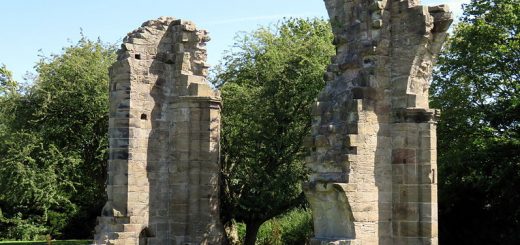St Oswald’s Church, Winwick
St Oswald, King of Northumbria (Born 604 – Died 5 August 642) was killed during the Battle of Maserfield (Maserfelth) against the pagan Mercian King Penda (Died 15 November 655). The site of the Battle of Maserfield is generally thought to be around Oswestry, however, Makerfield in Winwick also lays claim to it and site of St Oswald’s Church is thought to close to where the Northumbrian king fell.
 St Oswald’s Church is a Grade I listed building dating from 1358, though the Legh Chapel could be as early as 1330 and the bases of the north arcade are thought to be from the early 13th century. The building is thought to be on the site of an earlier church and there is a tradition that prior to this a pagan temple occupied the site. Three giant skeletons were discovered under the Chancel in 1828 which was thought to support this theory.
St Oswald’s Church is a Grade I listed building dating from 1358, though the Legh Chapel could be as early as 1330 and the bases of the north arcade are thought to be from the early 13th century. The building is thought to be on the site of an earlier church and there is a tradition that prior to this a pagan temple occupied the site. Three giant skeletons were discovered under the Chancel in 1828 which was thought to support this theory.
There is a siting legend attached to the church describing the events which led to the building being constructed there and the story concerns the ‘Winwick Pig’. The founder of the church had originally chosen another site “but after progress had been made at the original foundation, at night time, ‘a pig’ was seen running hastily to the site of the new church, crying or screaming aloud We-ee-wick, we-ee-wick, we-ee-wick.’ Then taking up a stone in his mouth he carried it to the spot sanctified by the death of St. Oswald, and thus succeeded in removing all the stones which had been laid by the builders.” [Antiquary, Vol. III]
There is a carving of a the ‘pig’ on the tower’s west wall. However, the pig was the symbol of St Antony of Egypt (Born 251 – Died 356) (aka Anthony the Great, Antony the Great, Saint Anthony, Anthony the Abbot, Anthony of the Desert, Anthony the Anchorite, Anthony of Thebes, Abba Antonius, and the Father of All Monks) and a statue of the saint was thought to occupy the niche beside the carving. The statues were renoved by the forces of Oliver Cromwell during the English Civil War (1642–1651) and replaced in 1973.
Note: Edward Smith (27 January 1850 – 15 April 1912), Captain of the RMS Titanic married Sarah Eleanor Pennington here on 13 January 1887.



Re: St Oswald’s Church, Winwick
WINWICK CHURCH.
The parish church of Winwick stands near that miracleworking spot where St Oswald, King of the Northumbrians, was killed. The founder had destined a different site for it, but his intention was overruled. Winwick had not then even received its name, the church being one of the earliest erections in the parish. The foundation of the church was laid where the founder had directed; and the close of the first day’s labour showed that the workmen had not been idle by the progress made in the building. But the approach of night brought to pass an event which uttedy destroyed the repose of the few inhabitants around the spot. A pig was seen running hastily to the site of the new church; and as he ran he was heard to cry or scream aloud, " We-ee-wick, we-ee-wick, we-ee-wick." Then, taking up a stone in his mouth, he carried it up to the spot sanctified by the death of St Oswald, and thus employing himself through the whole night, succeeded in removing all the stones which had been laid by the builders. The founder, feeling himself justly reproved for not having chosen that sacred spot for the site of his church, unhesitatingly yielded to the wise counsel of the pig. Thus the pig not only decided the site of the church, but gave a name to the parish. In support of this tradition, there is the figure of a pig sculptured on the tower of the church, just above the western entrance; and also the following Latin doggrel: —
"Hie locus Oswalde, quondam placint tibi valde ;
Northanhumbrorum fueras Rex, nunc que Polonim
Regaa tenes, loco papus Marcelde vocato."
"This place, Oswald, formerly pleased thee greatly ;
Thou wert King of the Northumbrians, and now of the Poles (?);
Thou boldest the kingdom in the place called Marcelde " [Macer or Mackerfield].
There are other churches in Lancashire besides Winwick whose sites have been changed by the devil, and he has also built some bridges ; that at Kirkby Lonsdale owes much of its beauty to the string of his apron giving way when he was carrying stones in it The stones may be seen yet in the picturesque groups of rock below the bridge. According to some a priest, according to others the devil, stamped his foot into the church wall at Brindle, to prove the truth of Popery ; and George Marsh the martyr did the same at Smithell’s Hall, to prove the truth of Protestantism. The footmarks still remain on the wall and the flag. There is great sameness in these traditions, one story doing for several places, except that at Winwick it was as a pig, at Leyland as a cat, and somewhere else as a fish, that Satan played his pranks. — N, ana Q., vi. 71.
[‘Lancashire Legends’ (1873) by John Harland & T T Wilkinson]